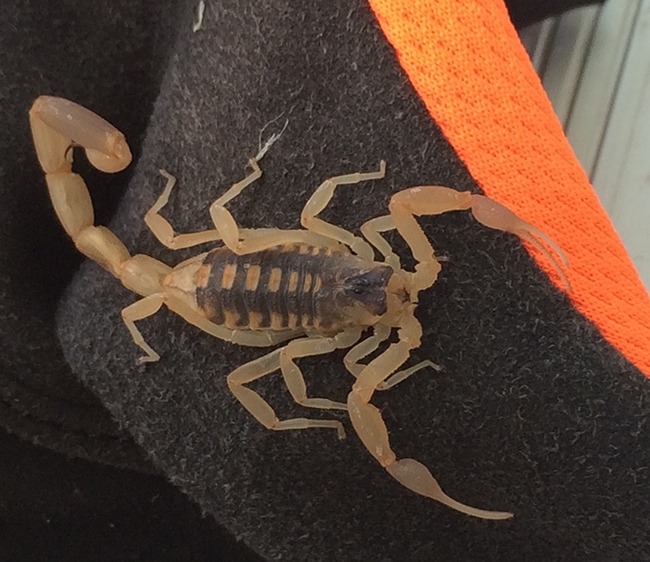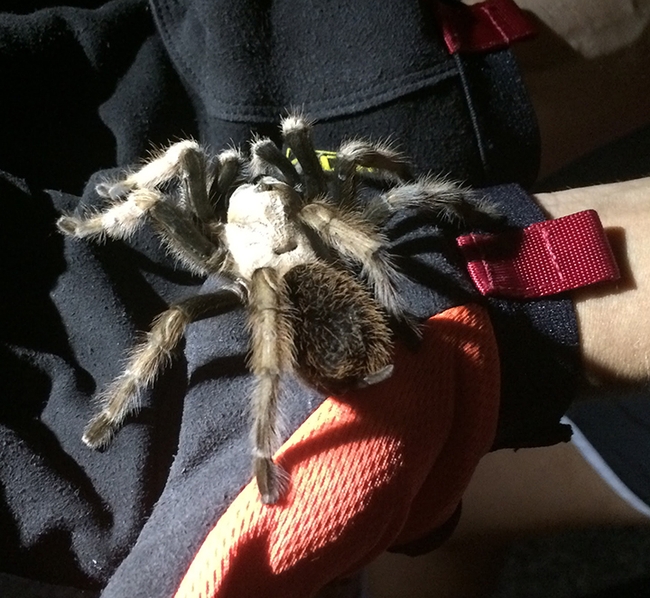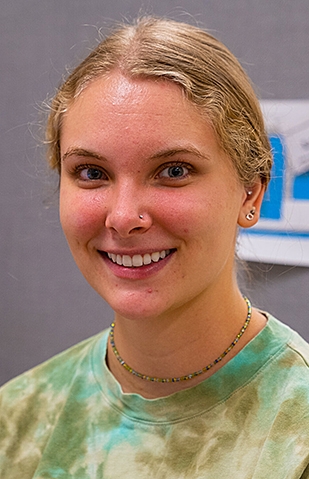
Annie is a pet scorpion belonging to Emma Jochim, a second-year doctoral student n the Jason Bond lab, UC Davis Department of Entomology and Nematology.
"She's an Anuroctonus pococki so I call her 'Annie' for short!" said Jochim. "The common name is 'Californian swollen stinger scorpion' because they have an extra 'bulb' on their telson that most scorpions don't, so I think that's pretty neat about this species. I haven't tried to handle her because she seems pretty aggressive--stinging crickets/roaches as soon as I put them in front of her and attacking water when I pour some in her enclosure."
Jochim's labmate, Xavier Zahnle, found the scorpion while he was collecting millipedes "and brought her back to me so I'm not sure how old she is but I've had her for a year and a half."
Emma holds a bachelor's degree in biology, with a minor in geology and chemistry, from Millsaps College, Jackson, Miss., where she graduated summa cum laude. Her honors thesis: "Species Delimitation of Vaejovis Scorpions from the Santa Catalina Mountains Using Genetic, Morphological, and Geographical Data." While a student at Millsaps College, her outreach activities including sharing her knowledge of tarantulas, scorpions and vinegaroons at the Mississippi Museum of Natural Science.
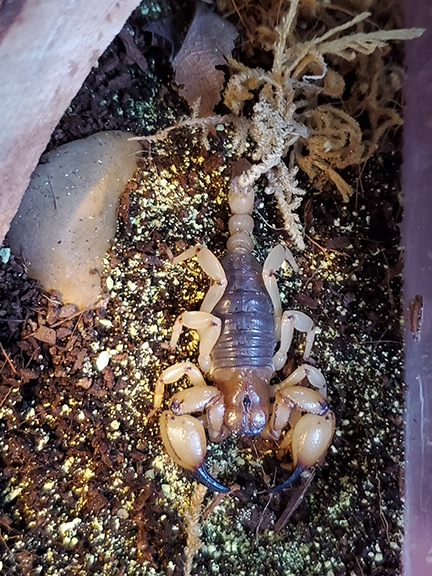
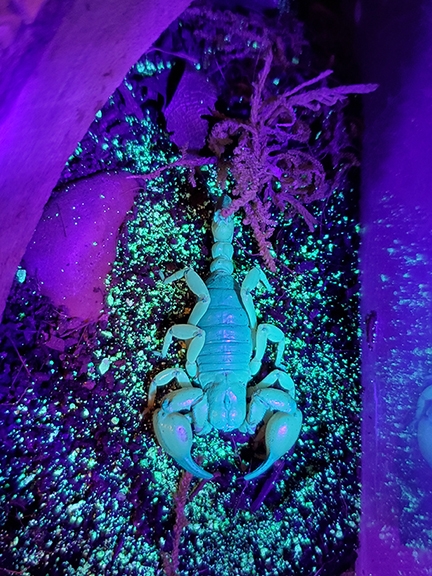
"Annie" will be just one of the live animals displayed in the Bohart Museum of Entomology/Jason Bond booth in the Conference Center. The Bond section also will include a live trapdoor spider (genus Hebestatis), a tarantula and millipedes, as well as specimens.
Doctoral candidate Lacie Newton of the Bond lab is coordinating the arachnid/myriapod section. Jason Bond, her major professor, is the Evert and Marion Schlinger Endowed Chair in Insect Systematics, UC Davis Department of Entomology and Nematology, and associate dean, College of Agricultural and Environmental Sciences.
"And there will be and a small interactive station where people will be able to use props that mimic an insect flying into a web and learn more about the sensory structures that spiders have to detect those vibrations," Newton said.
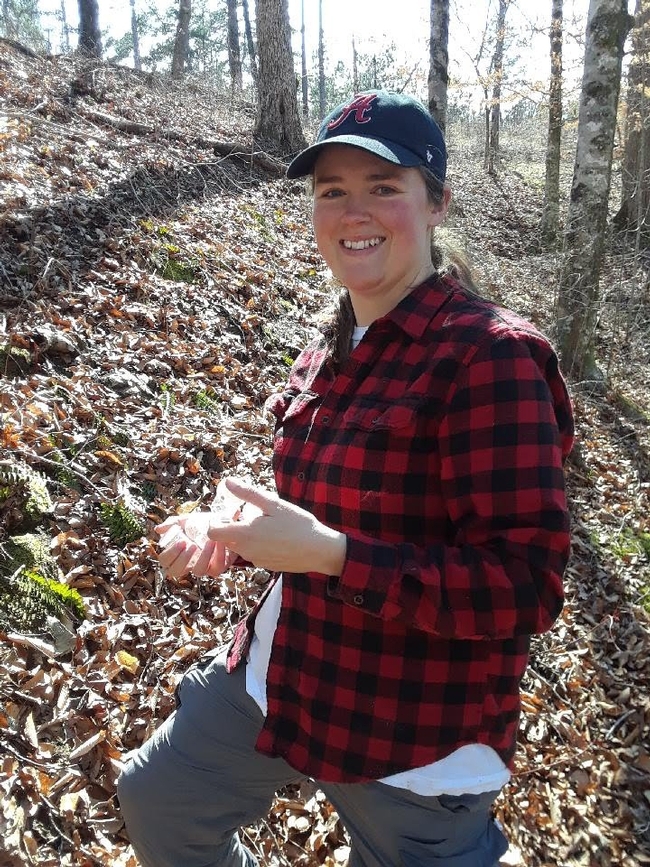
Eleven Museums, Collections. Scientists from a total of 11 museums or collections will staff booths in the Conference Center. Represented will be the Arboretum and Public Garden, UC Davis Bee Haven, Bohart Museum of Entomology, Botanical Conservatory, California Raptor Center, Center for Plant Diversity, Department of Anthropology Museum, Museum of Wildlife and Fish Biology, Nematode Collection, Paleontology Collection, and the Phaff Yeast Culture Collection. Visitors can sign up at the Conference Center for tours of several of the museums or collections. (See news story)
The UC Davis Biodiversity Museum Day is traditionally held on the Saturday of Presidents' Day weekend. However, last year's event was virtual, and this year's event is centrally located in an exposition. For more information, access the UC Davis Biodiversity Museum Day website and/or connect with Instagram,Twitter, and Facebook.
Bohart Fact Sheets on Scorpions. Lynn Kimsey, director of the Bohart Museum and UC Davis distinguished professor of entomology, has published two Fact Sheets about scorpions on the Bohart website.
Scorpions are arachnids, Kimsey writes, "and like all arachnids, they have eight legs, although it looks like ten, and a body divided into two regions, the cephalothorax (the head plus thorax) and the abdomen...The scorpion exoskeleton is different from that of similar groups. Something about it causes scorpions to fluoresce bright blue to green under ultraviolet light. So in the desert its easy to find them at night with a black light."
Kimsey describes scorpions as "nocturnal predators. During the day they hide under stones, logs or boards, or in cracks and holes in the ground. They prey on ground-dwelling insects and other small animals. Scorpions will occasionally wander into homes, particularly in new housing developments. New housing developments often encroach upon the scorpions' normal habitat and as a result these animals will blunder into homes searching for prey and shelter. Within several years, scorpions will no longer live in these areas because of the lack of suitable habitat and prey."
"The majority of California scorpion species average about 2 inches long as adults, however, some exotic species can be as long as 6 inches. Scorpions occur throughout the milder parts of California, including the Sierra foothills and the coastal mountains. Most of the species of scorpions in California pose no more threat to humans than do ordinary bees and wasps."
How long do they live? "Adult scorpions generally live two to three years," Kimsey relates. "They do not begin producing young until they are nearly a year old. Females produce between 20 and 30 live young at a time. Young scorpions are carried on the female's back for the first 5-15 days of life."
Read the two scorpion posts on the Bohart Museum website: one on scorpions in general and the other on sun scorpions. Sun scorpions, or solfugids, are distantly related to both scorpions and spiders.
Attached Images:
